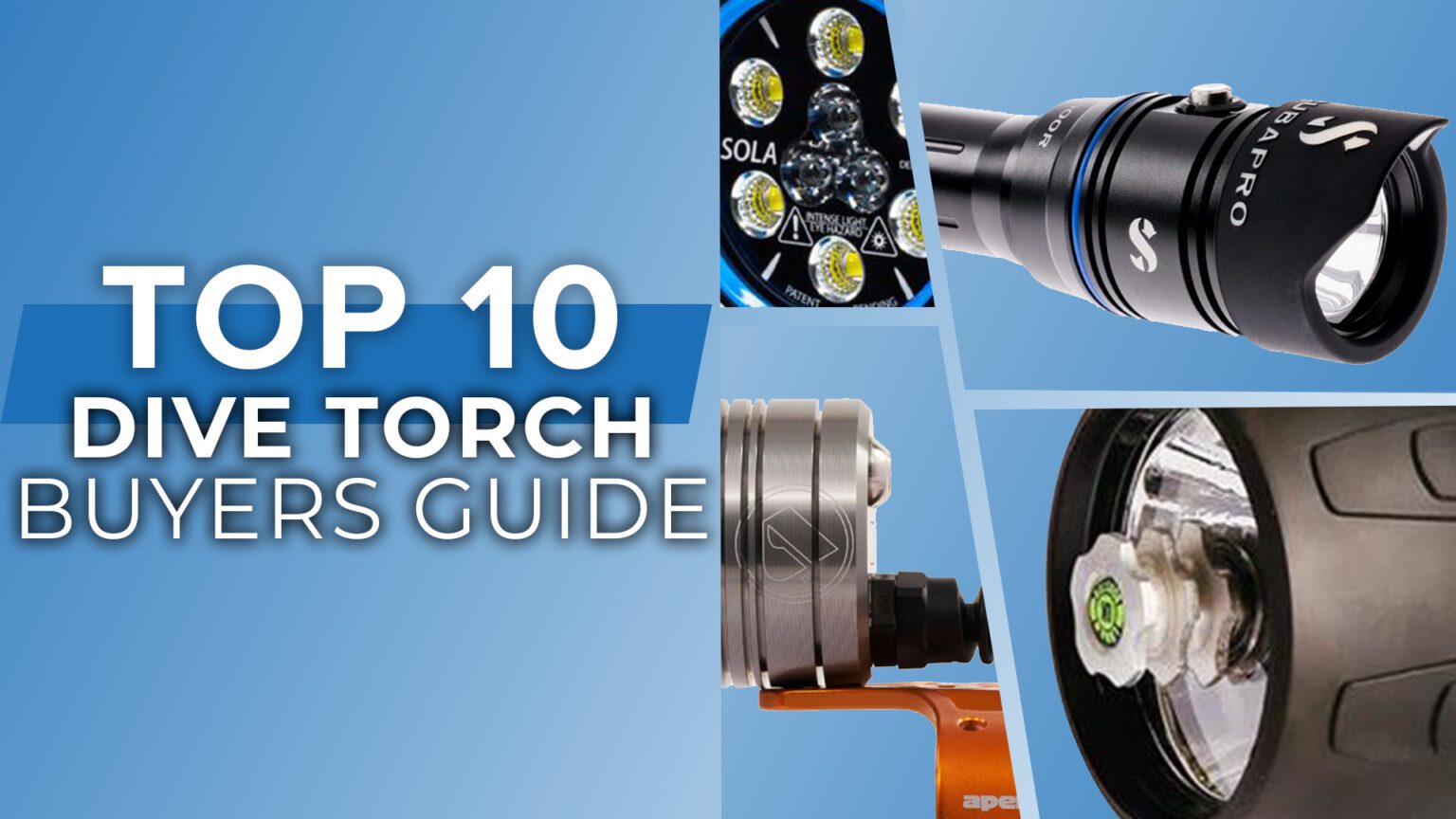Dive Torch Buyers Guide. Gone are the days when you need a flare to light your way underwater, that’s what the little dude in the PADI logo is holding by the way. We don’t have HID, halogen or xenon bulbs any more. I mean, they do exist still but, most modern dive lights run LEDs so you don’t need to worry about changing bulbs any more.
Lumens
Most torches have their power or their brightness listed in lumens. Explaining exactly what a lumen is can be a little complicated but, the weakest dive light will produce 10 lumens, and a very powerful video light 36,000 lumens. 700 lumens is my sweet spot for an all-rounder. For night dives in clear water if you shine your torch on the white sand or even on your gauges you’ll blind yourself with anything more powerful. 700 will be nice and bright to see around you without dazzling everybody around you.
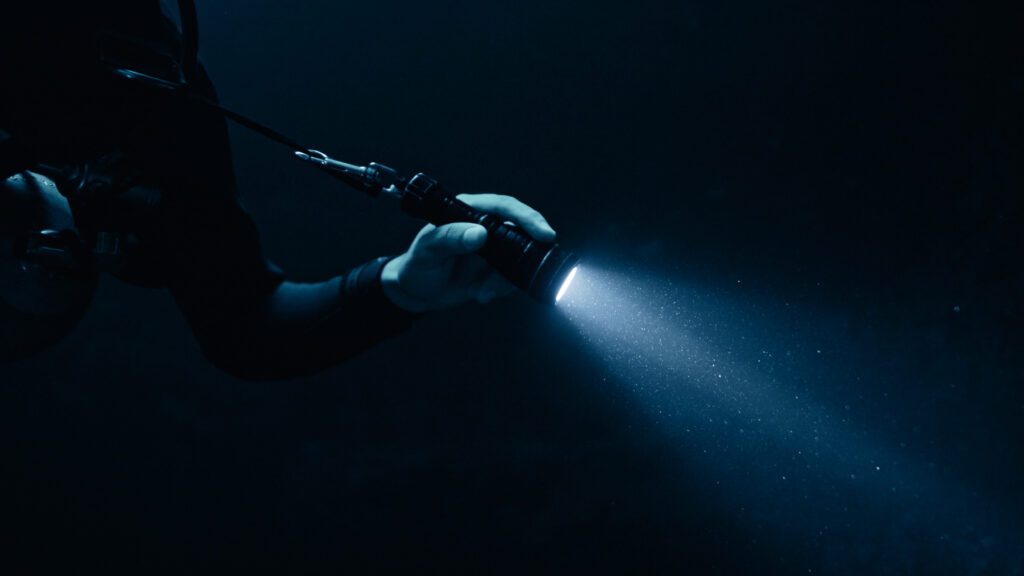
Brighter torches are better if you dive in murky water with poor visibility, anything over 1000 lumens and preferably a spotlight. And if you’re ever lost at sea then you want the brightest light possible so that you can be seen from greater distances. Luckily for us, many modern torches have power settings where you can change between max power, a medium setting, a power-saving low setting and usually a SOS strobe. If you can find one in your budget that has a 500 to 700-lumen setting then you’re on to a winner, any power setting over that is a bonus.
Beam angle
Beam angle is very important and it’s basically how wide those lumens are concentrated. Either to a small point that we usually call a spotlight with a 10 to 20-degree angle. To a wide floodlight that casts the light over a wider area. Floodlights tend to have beam angles more akin to 100 to 160 degrees. Which to choose is up to what the light is going to be used for.
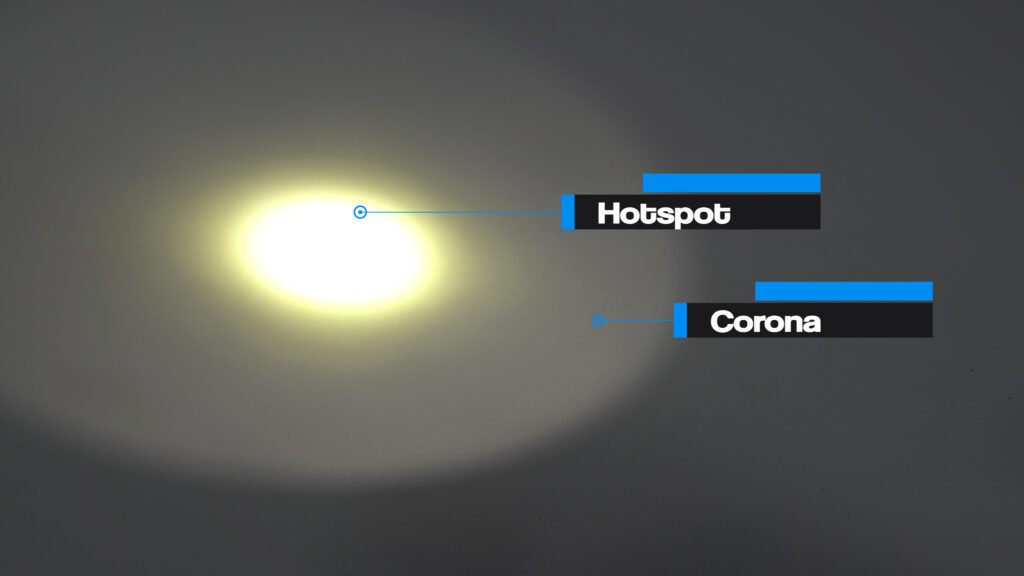
For general use, you want a spotlight. Floodlights are best for photos and videos but for general diving, you’ll dazzle everybody in front of you and because the light is spread so thin you won’t get the benefit unless it’s a really powerful torch. For spotlights though, you don’t want to get a beam angle that’s too small, it’s like trying to light your way with a laser beam. Check to see if your torch has a corona around the main beam where a small amount of light bleeds out to light the way but, you still get a tight beam that you can communicate and light the way.
Battery
Here we get to the interesting choice and it very much depends on the diver. There are three common avenues when it comes to torch batteries. Replaceable batteries, built-in rechargeable and replaceable rechargeable batteries. Standard replaceable batteries, you open the torch up and swap the batteries when they’re dead, or close to it hopefully. But, every time you open the torch you wear the seal and you either run the risk of diving with a near-empty battery or waste that charge and replace it.
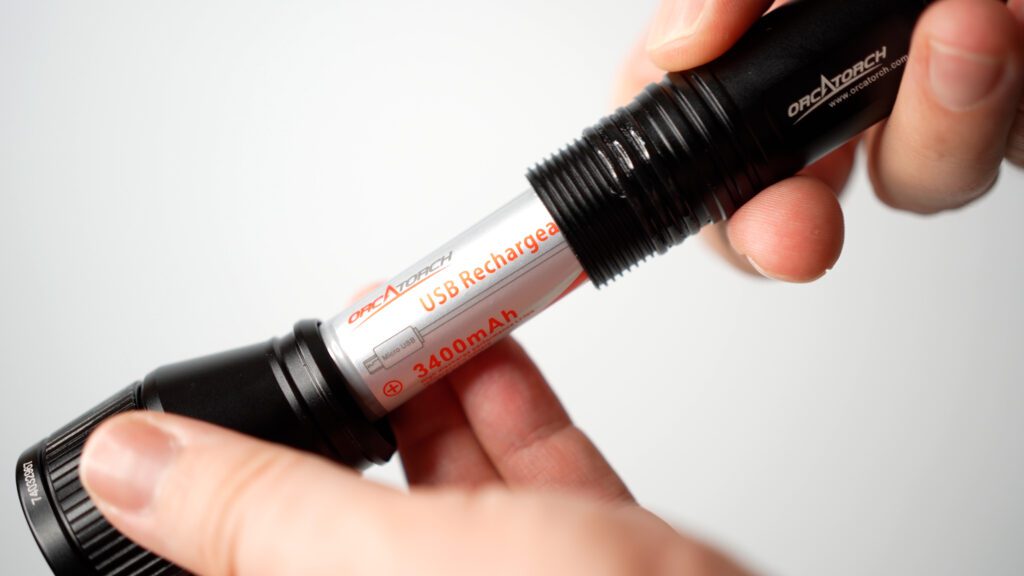
Factory-sealed batteries are the most convenient. Much like your smartphone, you can top the battery whenever you want from a powered USB. And you don’t need to worry about flooding because you don’t open the torch up. The downside is that eventually, the battery won’t hold its charge. Replaceable rechargeable batteries are sort of the best of both worlds: you can top up the battery as you need to and when it gets too old you swap it over. You still need to look after and replace that seal though to prevent flooding. Which is the best option for you is your choice, I have a mixture, and as long as you charge the rechargeable ones properly you can maximise their lifetimes.
Body
Most torches today are standard handheld designs. It’s a cylinder, usually anodized aluminium or plastic, and that’s where the batteries go. All of the clever stuff goes on in the head which holds the bulb, circuit board and switch. Plastic is cheap and light but, fairly weak compared to aluminium. We don’t tend to see a lot of variety outside of that such as titanium or steel. Aluminium usually gets the job done.
We don’t see too many pistol grip torches or lantern grips any more but, we do see a few Goodman handles. Goodman handles are named for a WKPP diver who developed the concept and they allow you to mount the torch to the back of your hand. They’re either made from metal, polymer or fabric and they tend to be the most common handle design today other than just a basic torch that you just hold in your hand. Photo and video lights tend to have their own range of poseable mounts so they can fix to the arms of your camera housing.
Buttons & Switches
This is quite important for me, you’ll find twisty torches, push buttons and flip switches. Twisty torches you screw the head or tail of the torch to turn it on or off. These are typically just on/off switches, it’s hard to change settings because you can’t press and hold like a button. And you do run the risk of just unscrewing it in the water thinking you’re turning it on or off and just wearing that O-ring seal over time.
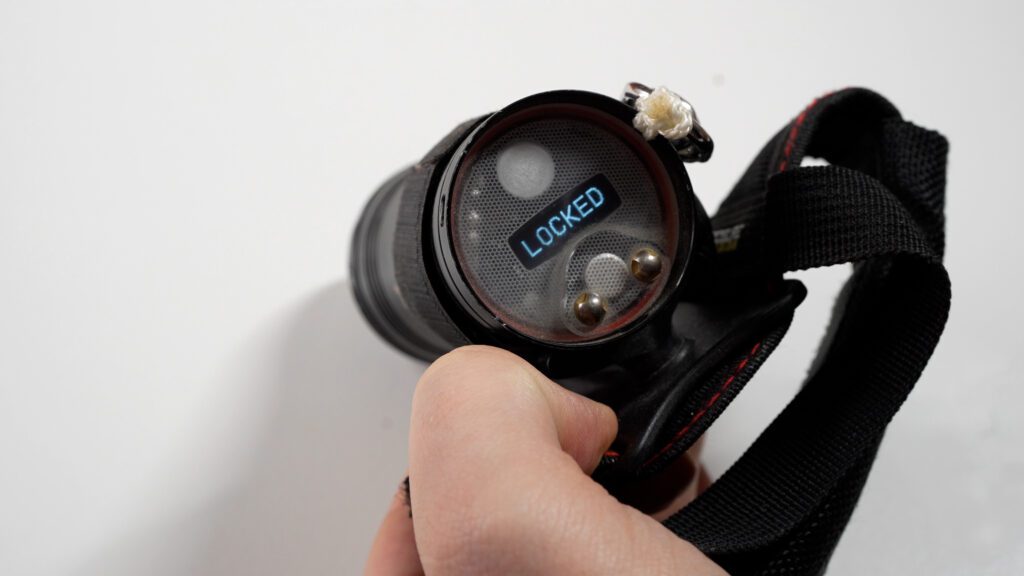
Flick switches can have several settings and they usually use magnets and reed switches so there’s less chance of flooding. But, there are moving parts and if the magnet isn’t sealed properly they can rust away. Buttons are similar but, you have more control when it comes to short or long presses. Look for a locking mechanism, because a button can be pressed in storage or travel and either drain your battery or cook your torch without you knowing so a locking mechanism is a good feature and you find them on a lot of modern torches.
Power Indicators
You’ll see around the button of some torches a clear plastic ring. Underneath this are some coloured LEDs that indicate either the battery level, power output level or both. They’re typically a traffic light system, green and you have lots of charge or it’s the maximum power setting, amber light and you’re starting to run low, you get the idea. When you first turn the torch on or change the power setting the ring indicates the power setting for a few seconds then switches to battery power.
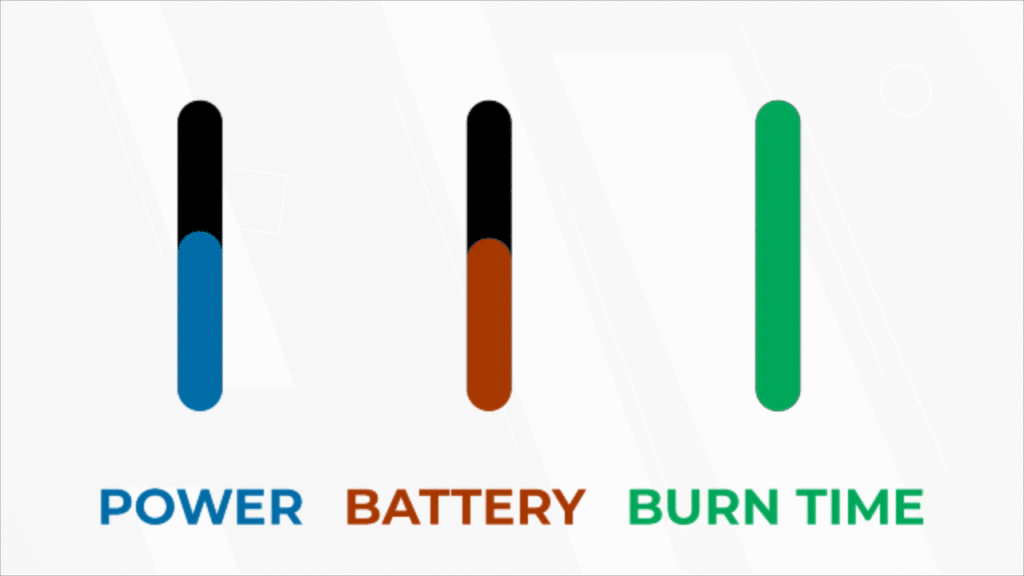
A rare few torches have a little screen somewhere that will spell out everything in words which is great, but, they’re pretty expensive so you don’t see too many of these out there. They’re also most common on rechargeable torches because they know the battery that’s fitted but, it’s great to have a rough indicator of how much juice you have left before topping it up or swapping it over.
Beacons & Strobes
Beacons and strobes are location markers. They range from chemical glow sticks to full-on emergency SOS strobes. Chemical glow sticks are single-use which is very wasteful and best avoided but, they’re cheap and come in a range of colours to mark things in the dark. Electronic blinkers are low-power, compact beacons to help mark things in the dark, you attach it to your tank valve so your buddy can see you or clip it to the hang tank so you can have a visual indicator of where your exit point is.
Emergency strobes are high-output strobes like a photo camera for use on the surface if you’re lost at sea. The high-output flash catches the attention of search and rescue without devouring the battery or cooking the bulb. If you run a more powerful torch on the surface constantly it can get so hot it can damage itself. Most underwater torches use the water around them to dissipate the heat, it’s why you see all of these heat syncs and some torches have circuitry to shut the torch down if it gets too hot.
Photo-Video
Outside of looking into a dark shipwreck or overhang, if you want to take pictures or video underwater then you need a light source to bring the true colours back. A good video light will be a floodlight with no hot spots or hard edges. Hot spots, like on the spotlights, will have a bright spot in the centre that will stand out in your images and hard edges to the corona will also stand out. So you want a nice even cast of light that gently tapers off at the edge to seamlessly illuminate the scene.
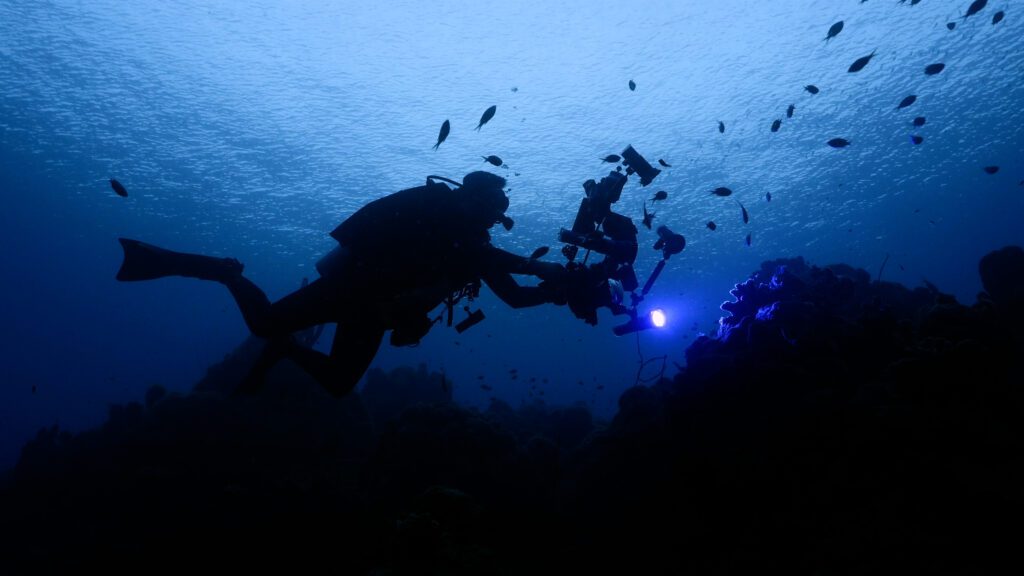
Red lights can be useful with some subjects because a lot of marine species can’t see the red light. And where the full white light would scare it off, the red light lets you line up your shot and pull focus before you use a strobe. Some photo lights have light sensors that can dim and brighten the light as needed or turn it off if it sees a photo flash to prevent back-scatter
Cables & Umbilicals
Output, power and burn time all go hand in hand. As you increase power, your burn time drops unless you increase battery size with it. For divers who need both a powerful output AND a long burn time, you need a bigger battery. But there’s only so much that you can fit in your hand without biceps like Schwarzenegger and that’s where cable lights come in.
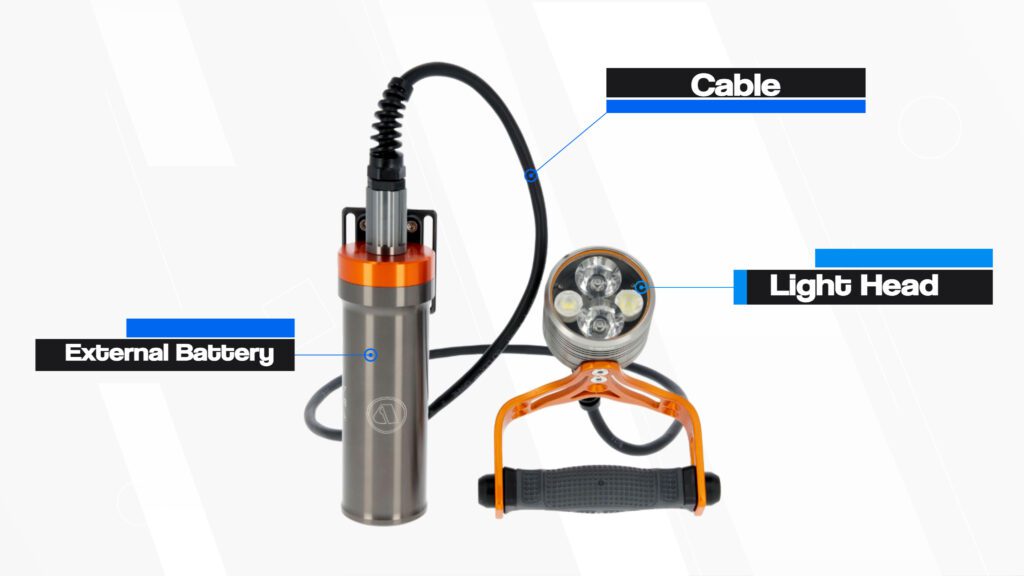
With an external battery that you can connect to a separate light emitting head with a cable. You can have a huge battery that you mount to your hip or behind you and a small head that you hold onto. They also have the benefit that if you fumble the torch head, it’s attached to the battery, which is hopefully securely fastened to you also so, it shouldn’t go too far. For a relentlessly powerful torch or one that has days of burn time, cable lights are the way forward.
Extras
Underwater lasers are starting to crop up. Either as stand-alone laser pointers or a laser emitter in a conventional torch and they do have their use. If you want to point at something underwater you can shine your torch beam on it, or ideally circle it, but this can spook some subjects that don’t like lights shone in their eyes or you can gesture, which has range and accuracy issues. And if you don’t want to put your finger up close to something, you can lasso it with your laser and not risk getting too close or disturbing it very much.
Adjustable beam angles are out there and I like them. Why pick or choose between a spotlight or a floodlight when you can adjust the beam angle on the go in the water? I prefer ones with a twisty collar to a telescopic collar, I find the twisty ones a bit more accurate. The anchor point is important. You always want to have a lanyard or a clip to prevent losing the torch and a tiny hole limits what you can poke through that hole. Bigger holes allow for more loops or a thicker line to make it more secure.
Dive Torch Buyers Guide
Otherwise, it’s just down to your specific needs. If you need a compact backup torch they’re out there but, they tend to be as powerful or even more powerful than primary torches 20 years ago. There are plenty of torch solutions out there and most brands are pretty trustworthy. Just be sure that you can get in contact with them if something happens. It’s not unusual for torches to flood and while it’s often caused by user error and we can tell I’m afraid, sometimes torches just flood but, if you can’t even find the contact details for the brand easily, then you’re stuck for getting a replacement under warranty.
